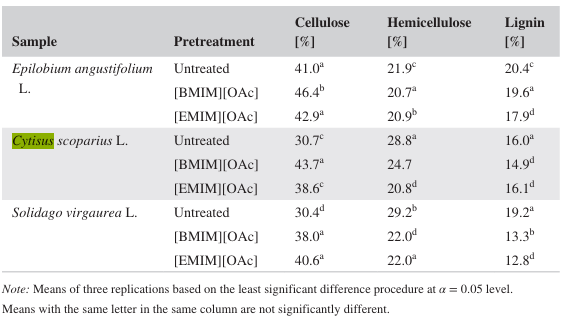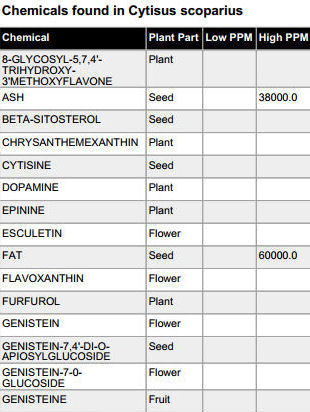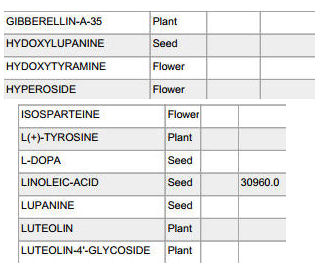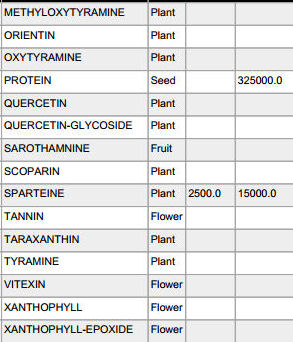Scotch Broom - Cytisus scoparius
Family: Fabaceae/Leguminosae (Pea)
Other Names:
common broom; Scot's broom; Scottish broom [E-flora]
- Caution (Cardiac Alkaloids), Flower Buds, Seeds, Hops Substitute, Fibre, Dye, Tannin, Perfume, Hair Wash, Herbal Smoke (caution), Wood, Birthing aid, Heart Medicine, External Uses,
Hazards
- Contraindicated: During pregnancy. [Leung ECNI] Abortive effect. [PDR] Broom tops are contraindicated in patients with high blood pressure. [Leung ECNI] Children younger than 18 years of age should avoid use due to potentially life-threatening toxicity. [NNF] "MAO inhibitors lead to sudden blood pressure changes" [PTH]
- Drug Interactions: "Use of Scotch Broom herb with monoamine oxidase inhibitors (amine content) may cause a hypertensive crisis." [PDR]
- No adverse side effects have been reported when the plant is properly prepared and smoked[EHMEFD] Health risks or side effects following the proper administration of designated therapeutic dosages are not recorded. [PDR]
- Cytisine is toxic.[EHMEFD] Broom contains "...several toxic alkaloids that can depress the heart and nervous system." [PCBC2004]
- "Too large a dose is unpleasant, as it creates almost the opposite effects of more moderate doses. In overdose, it weakens the heart, lowers blood pressure, and depresses the system, somewhat like hemlock in its actions." [Buhner SHHB]
Food Uses
- Flower Buds: "Pickled and used as a substitute for capers[4, 46, 183, 244]. They can also be added to salads[183]. Some caution is advised, see the notes above on toxicity." [PFAF]
- Seeds: "The roasted seed is a coffee substitute[2, 4, 115, 183]." [PFAF]
- Tops: "The tender green tops of the plant have been used like hops to give a bitter flavour to beer and to render it more intoxicating[4, 183]." [PFAF]
Other Uses
- Fibre
- Part(s) Used:
- Root: "The fibre is obtained from the root according to other reports[13, 46]." [PFAF]
- Bark: "The bark fibre is used to make paper, it is 2 - 9mm long[189]. An excellent fibre is obtained from the bark, it is used in the manufacture of paper, cloth and nets[4, 100, 115]." [PFAF]
- Stem: "The fibrous stems were used to make cloth. (Hochovsky 1985)" [GHB]
- Preparation: "The branches are harvested in late summer or autumn, the leaves removed and the stems steamed until the fibres can be stripped. The fibres are cooked for 3 hours in lye then put in a ball mill for 3 hours. [189]." [PFAF]
- Properties: "The paper is pale tan in colour[189]. Fibre not as strong as the fibre from the Spanish broom (Spartium junceum)[4]." [PFAF]
- Dye: "A yellow and a brown dye are obtained from the bark[46]. A yellow dye is obtained from the flowering stem[169]. A green dye is obtained from the leaves and young tops[4]." [PFAF]
- Branches: "Used to make baskets, brushes, brooms and besoms[4, 6, 13, 46, 55, 115]. They are also sometimes used for thatching roofs and as substitutes for reeds in making fences or screens[4]." [PFAF]
- Tannin: "The bark is a good source of tannin [4]." [PFAF]
- Essential Oil: "From the flowers, it is used in perfumery[57]." [PFAF]
- Hair Rinse: "flowers used in hair rinses for their lightening and brightening effect". [Leung ECNI]
- Fumigant: "In the Scottish highlands, tips of Scotsbroom were burned to use as fumigants for unspecified purposes." [UAPDS]
- Smoke:
- Effects: "Intoxication, relaxation, euphoria, intellectual clarity, and a heightened sense of color for about two hours. It may also produce intense hypnagogic imagery (hypnagogia is the half-awake, half asleep state that can occur just before or after sleep), but not hallucinations. In Europe, it has been used as an ingredient in aphrodisiac drinks. It is used by the Yacqui medicine men of northern Mexico as a supposed hallucinogen, even though its cytisine alkaloid has not been proven to have psychoactive properties." [Under; Broom, Cytisus canariensis, Cytisus scoparius (Scotch broom), Genista canariensis (Canary Island broom), Spartium junceum (Spanish broom).] [EHMEFD] When smoked in cigarette form, headache, confusion, relaxation, and euphoria may occur. Driving or operating heavy machinery should be avoided. Smoking cigarettes containing scotch broom carries a risk of inhalation of fungal contaminants (aspergillus), with a possibility of resulting fungal pneumonia. [NNF]
- Dosage: "Up to one joint of dried leaves is said to produce a relaxed feeling with no subsequent depression; several joints may produce the effects mentioned above. The blossoms of the plant are aged for about 10 days in a sealed jar until they are dry and moldy, then ground up and rolled into a joint. All 3 varieties (Cytisus and Genista) have about the same potency."[EHMEFD]
- Wood: "Very hard, beautifully veined[4]. The plant seldom reaches sufficient size for its wood to be of much value, but larger specimens are valued by cabinet makers and for veneer[4]." [PFAF]
Medicinal Uses
"Scotch broom herb has been taken by mouth traditionally for a variety of conditions related to the heart or blood circulation. These include abnormal heart rhythms (arrhythmias), fast heart rate (tachycardia), swelling in the legs (peripheral edema), water in the lungs (pulmonary edema, congestive heart failure), and low blood pressure (hypotension)." [NNF]
- Birthing Aid: "Scotch broom herb has been used historically to stimulate uterine contractions at birth and to reduce post-partum hemorrhage (bleeding after birth). There is a scientific basis of this use, due to the presence in scotch broom of small amounts of the alkaloid sparteine, which was studied and used through the 1970s as an oxytocic drug (to induce labor). This use was discontinued due to serious toxicities associated with sparteine....The safety and efficacy of scotch broom preparations in labor are not well studied or established. Women who may require labor induction should be evaluated and supervised by a physician." [NNF]
- Heart Medicine: "Broom is a bitter narcotic herb that depresses the respiration and regulates heart action[238]. It acts upon the electrical conductivity of the heart, slowing and regulating the transmission of the impulses[254]." [PFAF] "...for patients with congestive heart failure to help regulate heart rhythm and indirectly improve venous return....as a specific treatment for atrial or ventricular fibrillation and extrasystoles." [16][CBMed]
- Various other uses: "Reportedly used internally as a diuretic and externally to treat sore muscles, abscesses, and swellings;...Broom flowers, seeds, and root as well as the whole herb have reportedly been used in treating tumors.[7] [Leung ECNI]
- Tips & Seeds: "The young herbaceous tips of flowering shoots are cardiotonic, cathartic, diuretic, emetic and vasoconstrictor[4, 13, 21, 46, 165]. The seeds can also be used[4]. The plant is used internally in the treatment of heart complaints, and is especially used in conjunction with Convallaria majalis[238]. The young herbaceous tips of flowering shoots are harvested in spring, generally in May[4]. They can be used fresh or dried[4, 238]. They should not be stored for more than 12 months since the medicinally active ingredients break down[238]." [PFAF] "The seeds may be used much as the flowering tops are employed." [Buhner SHHB]
- Flowers: "The flowers, early in their season, are thought to be stronger, they do not keep their properties well upon drying." [Buhner SHHB]
- "The bitterness of broom, of course, makes it useful in ales, which always benefit from some bitter agent to balance the sweetness of the malt. The tannins are additionally of benefit in brewing flavor, especially in mead fermentation. Ingestion of sufficient broom results in inebriation, staggering gait, and impaired vision. Greater amounts result in vomiting and profuse sweating." [Buhner SHHB]
Extracts
"Cytisus scoparius, possess a yearly flowering cycle and seasonal variations in extractives yield and compositions were observed. From a previous study the seasonal chemical characterization of the ethanolic extracts revealed that maximum extraction yields were attained in Winter. The maximum phenolic content was observed in February-April, the most abundant in decreasing order being rutin, isoquercetin, kaempferol, quercetin, syringic acid, 3,4-dihydroxybenzaldehyde, acetovanillone, vanilline, naringin and hesperidin. From the studies processing the solid residue obtained after the ethanolic extraction under optimized conditions in a pressurized reactor at temperatures between 150 and 240 °C, it was observed that the maximum solubles and phenolics extraction yields could be attained at 190-210 °C." [Conde, Enma, et al.]
"Cytisus scoparius branches collected in Winter presented higher content of radical scavenging compounds. A combination of extraction stages using biorenewable clean solvents was proposed for the production of enriched phenolic extracts with antioxidant properties from Cytisus scoparius. The extracts were comparable to those obtained with conventional solvent extraction with ethanol." [Conde, Enma, et al.]
Fiber
"Cytisus scoparius samples were processed with hot, compressed water (autohydrolysis treatments) to obtain both fiber-containing solids (suitable as reinforcements for composites) and a liquid phase containing sugar oligomers derived from hemicelluloses. The solid phase from autohydrolysis, mainly made up of cellulose and lignin, was employed for manufacturing polylactic acid (PLA)-based biodegradable composites." [González, Daniel, et al.]
Bioethanol
"Among the perennial plants, fireweed (Epilobium angustifolium L.) and European golden rod (Solidago virgaurea L.) can be distinguished. Moreover, from the family of shrub plants one can distinguish common broom shrubs (Cytisus scoparius L.).A common feature of all three plants is the structure and composition of their stems, which contain about 20% lignin, 40% cellulose, and 25% hemicellulose. All three species require very modest soil quality and therefore can be an interesting source of biomass." [Smuga‐Kogut, Małgorzata, et al.]
 [Smuga‐Kogut, Małgorzata, et al.]
[Smuga‐Kogut, Małgorzata, et al.]
Description
Synonyms
- Sarothamnus scoparius. [E-flora]
General Woody shrub [WildPNW] "...growing to 2.4 m (7ft) by 1 m (3ft 3in) at a fast rate." [PFAF] Unarmed. [PCBC2004]
Lifecycle Perennial.[WildPNW]
Flowers "The flowers are hermaphrodite... and are pollinated by Bees.The plant is not self-fertile." [PFAF] Bright yellow. [WildPNW]
Fruits "legumes 2.5-4 em. long, glabrous except for long hairs on the
margins. "[HNW] Black..."the two
halves tend to warp in different directions,
eventually snapping apart..." [PCBC2004]
Leaves "Alternate, deciduous, small,..." [PCBC2004] "Leaves are mostly 3-parted with entire leaflets."[WildPNW] "...sometimes tinged
with purple, typical 'pea'-flower,..." [PCBC2004]
Stem "Stems not round but angled with
5 edges..."[WildPNW]
Habitat "Mesic to dry fields, rocky slopes, roadsides and powerline rights-of-way..."[IFBC] [E-flora]
Range "locally common in SW BC..."[IFBC] [E-flora]
Status Exotic [E-flora] Invasive. [WildPNW]
Ecological Indicator
"A shade-intolerant, submontane to montane, European deciduous shrub introduced to Pacific and Atlantic North America. Occurs in maritime to submaritime summer-dry cool meso thermal climates on very dry to moderately dry, nitrogen-medium soils. Its occurrence decreases with increasing latitude, elevation, and continentality. Inhabits exposed mineral soil in earlyseral, non-forested communities on strongly drained, water-shedding sites. Symbiotic with nitrogen-fixing organisms. Characteristic of disturbed sites." [IPBC][E-flora]
Similar Species "There are several weedy species of the genus Cytisis that are found on the Pacific Coast and Cascade Mountains." [WildPNW] "Var. andreanus Dipp. A form having dark crimson wings is an occasional
escape from cultivation. [HNW]
Gorse - Ulex europaeus is another weedy introduced species. It has many thorns and yellow pea-like flowers "...smelling of coconut (or bruised peaches)". Gorse is much less common than Scotch Broom and ranges mostly on South East Vancouver Island.[PCBC2004]
Notes It can tolerate atmospheric pollution and maritime exposure. [PFAF] "A high percentage of broom seeds (greater than 65%) have been found to be impervious in some studies, which can delay germination from months to years, contributing to the seed bank (Bossard 1993)." [E-flora]
Ethnobotany
Lore: Broom is used in purification and protection spells, and is hung in the home to keep evil out. Also, an infusion of broom sprinkled through the house exorcises poltergeists. Although the infusion was once used as a drink to increase psychic powers, this can be dangerous because the plant is slightly poisonous; carry instead for this purpose.[EMH Cunningham]
Pharmacology
Diuretic: Scotch broom preparations, particularly those made from the flower, have been used traditionally as diuretics (to increase urination). Diuretic effects have been attributed by some to the constituent scoparin or scoparoside. [NNF]
Phytochemistry
|
Alkaloids
Simple amines
Flavonoids
|
Flavones
Isoflavones
Pigments
|



Contains "amino acids, volatile oil (containing 4-mercapto-4- methylpentane-2-one); coumarins, cafeic acid derivatives; tannin; wax; fat; and sugars".[Leung ECNI]
"Essential oil of the fresh flowers contains alcohols, coumarins, eugenol, benzoicacid, guaiacol, fatty acids,and others." [Leung ECNI]
Seed Oil FAs Composition, %: 12:0 – 0.1; 12:1 – 0.2; 14:0 – 0.2; 14:1 – 0.3; 16:0 – 16.7; 16:1 – 0.5; 18:0 – 4.4; 18:1 – 20.0; 18:2 – 51.6; 18:3 – 4.3; 20:0 – 0.6; 20:3 – 0.7; 22:0 – 0.4 [LLCEOPS]
"Since only sparteine can be easily isolated from broom (Cytisus scoparius), it is the only lupin alkaloid that is commercially available and exploited in medicine as an antiarrhythmic drug. However, about 10% of all patients are unable to metabolise sparteine and suffer from sparteine intoxication. Because of these side effects and the availability of more reliable synthetic heart drugs, the use of sparteine in modern medicine is declining and restricted. The utilisation of sparteine as a uterus-contracting drug has been abandoned for the same reasons." [Nagata MAPS 12]
Cultivation
"Succeeds in most soils, preferring a fairly good but not rich soil[11]. Prefers a poor well-drained soil[14]. Succeeds in slightly acid, neutral and limy soils but dislikes shallow soils over chalk[200]. Plants are strongly calcifuge according to other reports and intolerant of a pH much above 6.5[17, 186]. Prefers a sunny position but tolerates some shade[11, 14, 17]. Plants succeed in exposed conditions, and are very tolerant of maritime exposure[4, K]. Plants have a deep root system, they are very drought tolerant once established and grow well on dry banks[4, 11]. Tolerates a smoky atmosphere, growing well in polluted areas[186]. Plants are hardy to about -20°c[184]. A number of named forms have been developed for their ornamental value[182]. New leaves are formed in April but these soon drop off the plant, photosynthesis being carried out by means of the green stems[186]. Very tolerant of cutting, it regenerates quickly from the base[186]. Plants are usually killed by fire but the seeds quickly germinate after the fire and rapidly become established[186]. A good bee plant and food plant for many caterpillars[24, 30, 46], it provides the food for the larvae of the green hairstreak butterfly[186]. Ants are attracted to the seeds, feeding on the juicy attachment that holds them to the pods and thus distributing the seed[186]. Dislikes root disturbance, especially when more than 20cm tall[11]. It is best to plant out into their permanent positions as early as possible. This species has a symbiotic relationship with certain soil bacteria, these bacteria form nodules on the roots and fix atmospheric nitrogen. Some of this nitrogen is utilized by the growing plant but some can also be used by other plants growing nearby[200]." [PFAF]
Pests
"...Aphis cytisorum, which infests broom plants (Cytisus
scoparius), accumulates up to 0.5 mg alkaloid per gram fresh
weight. The alkaloids are similar in composition to those of
the host plant, 17-oxosparteine (25), sparteine (17), 12,13-
dehydrosparteine, and iupanine (21) (Wink et al., 1982). [Seiger PSM]
Propagation
Because of its strong seed coat dormancy, its seeds remain viable in the forest floor seed bank for up to thirty years.[82][GPG]
"Seed - best sown as soon as it is ripe in the autumn in a cold frame[80]. Pre-soak stored seed for 24 hours in warm water then cold stratify for 1 month and sow in a cold frame[80]. The seed usually germinates in 4 weeks at 20°c[98, 113]. Seedlings should be potted up as soon as possible since plants quickly become intolerant of root disturbance[186]. Plant them out into their permanent positions in late summer if they have made sufficient growth, otherwise in late spring of the following year[K]. The seed has a long viability[186]. Seed can also be sown in situ as soon as it is ripe in the late summer and autumn[4]. Cuttings of half-ripe wood, 4 - 7 cm with a heel, August in a frame[11]. Produces roots in the spring[11]. Pot up as soon as possible[11]. Cuttings of mature wood, October/November in a frame. Layering." [PFAF]
Uses of Other Related Sp
CYTISUS
Shrub, [small tree], unarmed.
Stem: often ribbed, green, to 5 m.
Leaf: 1-compound (generally ternate), generally alternate, petioled; stipules free or 0.
Inflorescence: generally terminal racemes, or axillary, peduncled clusters of 1–4(7) flowers.
Flower: calyx bell-shaped to cylindric, 2-lipped, upper lip ± 2-lobed, lower generally 3-lobed; petals 5, generally yellow or white, generally not hairy, keel oblong-sickle-shaped to ± 1/2 circular (curve abaxial), claw ± 1/4 keel; stamens 10, filaments fused; style generally abruptly curved at ± middle or gently curved ± throughout.
Fruit: dehiscent, generally oblong, papery to ± leathery; pedicel short.
Seed: few to many, generally arilled.
65 species: Europe, western Asia, northern Africa, Canary Islands; some cultivated. (Greek: name for several woody Fabaceae) Chamaecytisus (30 species) often segregated but recent work (Cristofolini 1991 Webbia 45:187–219; Cubas et al. 2002 Plant Syst Evol 233:223–244) supports treatment as 1 monophyletic group.
[Jepson]
Local Species
- Cytisus scoparius - Scotch Broom [E-flora]
- Cytisus striatus - Portuguese broom [E-flora]
| Ethnobotanical Uses and Properties of Various Cytisus Sp. [DukePhyt] | |
| Cytisus laburnum | |
| Asthma [Steinmetz]; Cholagogue [Steinmetz]; Emetic [Steinmetz]; Pertussis [Steinmetz]; Poison [Steinmetz]; Purgative [Steinmetz]; Tumor [Hartwell] | |
| Cytisus purgans | |
| Purgative [FontQuer] | |
| Cytisus scoparius | |
| Abortifacient* [Lewis]; Arrhythmia* [Woi.2]; Bruise [Bliss]; Cardiotonic [Takeda, Woi.2]; Cold [Bliss]; Cough [Bliss]; Diuretic [Steinmetz, Takeda, Woi.2]; Dropsy [Woi.2]; Emetic [Woi.2]; Palpitation* [Woi.2]; Poison* [Lewis, Steinmetz]; Purgative [Steinmetz, Woi.2]; Sedative [Steinmetz]; Smallpox [Bliss]; Tachycardia* [Woi.2]; Tea [Bliss]; Tumor [Hartwell]; Vasoconstrictor [Steinmetz] | |
Soil Conditioner
"Giesta (Cytisus) is the dominant or only
woody plant on about one-quarter of the land area of the high granite mesas of interior
Beira Alta, Portugal, where for at least the past 800 years the main cereal crop has been rye.
During this time, a substantial fraction of this crop has been sold and taken to cities to feed
the urban population, carrying with it nitrogen in the proteins of the grain. These farms have
remained sustainable for nitrogen in the face of this outflow because farmers have allowed
and even encouraged giesta, which is a nitrogen fixer, to occupy a substantial fraction of the
land area, from which it is harvested and buried in the cultivated soil to restore its fertility." [Estabrook]
"Cytisus albidus (= Chamaecytisus mollis) is regarded as one of, if not 'the' best browse species in Morocco (Shoenenberger, pers. comm. 1980) where it is an endemic species in the atlantic, coastal, semi-arid and arid sandy plains matorrals. Direct sowing has been used in the improvement of forest rangelands at altitudes up to 1000 m of elevation in the western High Atlas (Shoenenberger, ibid.)" [Wickens PAL]
"Cytisus villosus (= C. trij1orus) is a high rainfall browse species in the Quercus faginea and Q. suber forests." [Wickens PAL]
"...Yaqui medicine men from northern Mexico employ Genista canariensis, the genista of florists, for the purpose of inducing hallucinations (17), a property that has been experimentally substantiated. The genus Genista and the closely related Cytisus, in which Genista canariensis is sometimes included, are extremely rich in alkaloids. Cytisine, an alkaloid that formed the basis for the former hallucinogenic use amongst some North American Plains Indians of seeds of the leguminous ''Sophora secundiflora' (53), has been isolated from leaves and beans of Genista canariensis." [Ethsearchpsych]
References
- [CLQA] Cellular localization of quinolizidine alkaloids by laser desorption mass spectrometry (LAMMA 1000), M. Wink, H.J. Heinen, H. Vogt, and H. M. Schiebel, Plant Cell Reports (1984) 3:230-233
- Conde, Enma, et al. "Hydrothermal and supercritical combined extraction process of fractions with antioxidant activity from Cytisus scoparius." III Iberoamerican Conference on Supercritical Fluids Cartagena de Indias, Colombia. 2013.
- [Dihydrooxylupanine] (-)-3â,13á-DIHYDROXYLUPANINE FROM CYTISUS SCOPARIUS, Isamu Murakoshi, Yoshiaki Yamashita, Shigeru Ohmiya, and Hirotaka Otamasu, Phytochemistry, Vol 25, No 2, 1986.
- [DukePhyt] Accessed Feb 26, 2015
- [Duke2] Cytisus scoparius - https://phytochem.nal.usda.gov/phytochem/search, Accessed Aug 13, 2016
- [E-flora] http://linnet.geog.ubc.ca/Atlas/Atlas.aspx?sciname=Cytisus%20scoparius, Cytisus scoparius, [Accessed: 5/18/2014 6:52:03 AM ]
- [USDA] Cytisus scoparius, US Dept. of Agriculture, http://plants.usda.gov/core/profile?symbol=CYSC4
- [Estabrook]NEITHER WILD NOR PLANTED: ESSENTIAL ROLE OF GIESTA (CYTISUS, FABACEAE) IN TRADITIONAL AGRICULTURE OF BEIRA ALTA, PORTUGAL, George F. Estabrook, Economic Botany, 60(4), 2006
- [GHB] Getting a Handle on Broom; Scotch, French, and Portuguese Brooms in California, John W. Leblanc, 2001 University of California.
- González, Daniel, et al. "Manufacture of fibrous reinforcements for biodegradable biocomposites from Citysus scoparius." Journal of Chemical Technology & Biotechnology 86.4 (2011): 575-583.
- [GPG] ‘Glistening Patches of Gold’: The Environmental History of Scotch Broom (Cytisus scoparius) on Southern Vancouver Island, 1848-1950, Troy Van Lee, ISSN 0005-2949, BC Studies #166, Summer 2010, University of British Columbia
- [82] Peterson and Prasad, “Biology of Canadian Weeds,” 500, 501
- [Jepson]2013. Cytisus, in Jepson Flora Project (eds.) Jepson eFlora, http://ucjeps.berkeley.edu/cgi-bin/get_IJM.pl?tid=9324, accessed on Feb 21 2015
- [NNF] http://www.noahsnaturalfoods.ca/ns/DisplayMonograph.asp?storeID=25253c03182e4524acddb4f565e2742f&DocID=bottomline-scotchbroom, Cytisus scoparius (Dead Link) This information is based on a systematic review of scientific literature edited and peer-reviewed by contributors to the http://www.naturalstandard.com?
- [PFAF] Cytisus scoparius Plants For A Future, www.pfaf.org, Accessed May 18, 2014
- [SQA] A survey of quinolizidine alkaloids and phenylethylamine tyramine in Cytisus scoparius (Leguminosae) from different origins, by Gresser, G; Witte, L; Dedkov, VP; Czygan, FC, ZEITSCHRIFT FUR NATURFORSCHUNG C-A JOURNAL OF BIOSCIENCES, 11/1996, Volume 51, Issue 11-12
- Smuga‐Kogut, Małgorzata, et al. "Evaluation of the potential of fireweed (Epilobium angustifolium L.), European goldenrod (Solidago virgaurea L.), and common broom (Cytisus scoparius L.) stems in bioethanol production." Energy science & engineering 8.9 (2020): 3244-3254.